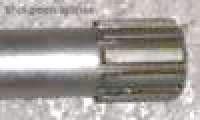

Chicagoland MG Club
Tech Tips
General Tips
MGA Tips
MGB Tips
Midget Tips
MGT Tips
MMM Tips
Tech Session
Photo Archives
|
|

Spridget Rear Axle
Half Shaft Break
by Norm Kerr - Ann Arbor, MI
to "spin and snatch" a rear wheel on the shoulder under power can snap an axle
bad wheel bearing (excess play = overloading the shaft while cornering)
bent axle housing (have a machine shop confirm true)
inboard shaft spline worn by the differential gear's mating spline (groove width wear on the shaft of more than +0.010" and it should be replaced. Also, the presence of this wear creates a stress riser at the most highly loaded portion of the shaft/spline)
==> photo before/after
Growlerize (*1) to minimize both the original stress riser where the spline cut ends, and also from the wear caused by the edge of the differential gear mentioned above.
weak material (pre '68 shafts, "ATA" part numbers, used only EN7, but from '68 BMC adopted EN17. Identify later axles by a groove machined at the end of the differential splines. Steel wheels use BTA806, wire wheels use BTA 807. For reference, BTA 939 and 940 were factory competition shafts.
==> photo before / after wear
==> is there an "EN17" marked on the outside, domed face?
axles swapped R x L (reversing the loading reverses the twist in the material and can lead to failure).
double bearings have been used in an attempt to increase shaft life, especially for racing, but some have had sealing issues with them, and some racers say they still use stock bearings, without ever breaking a shaft. Growler's treatment should be effective to minimize stress in the area where most fail (near the diff).
Peter May makes EN24 shafts.
Frontline makes EN40B nitrided shafts. Peter May says EN40B is too hard/brittle, "EN24 provides the best balance of strength and toughness".
both are about double the cost of new, stock axles.
When buying half shafts, or replacing the whole rear end, note that disc wheel axle housings are 1" narrower than wire wheel units, and have accordingly different length half shafts.
*1 - Growlerize the shafts (named for the screen name of Grant Bowyer, the Kiwi machinist on the MG Enthusiast BBS / UK who brought it to wider attention): cut down the diameter of the shaft to the root diameter of the splines, so the land between the splines stick "out", rather than the splines themselves sticking "in":
 Start the cut 1" from the end of the shaft (so that the very ends of the differential splines are over air, not against the face of the axle splines), and provide a generous radius at the end of the splines (the photo shows too sharp a transition, a big radius is what you want). Continue the root diameter for 4", then gradually taper over 6" back to the original diameter. De-burr and then shot peen (like is done with a connecting rod). Why does this work? The shaft itself is plenty strong enough to handle the engine torque, so reducing its diameter near the diff, although it gives up torsional stiffness, is offset by the benefit gained for strength by avoiding cracks at those eliminated stress risers, and removing the sharp corners at the end of the spline cuts, and eliminating the stress riser where the diff splines end, eliminates two key weaknesses in its design that lead to cracks/axle failure. Ideally, the reduced torsional stiffness caused by this diameter reduction will allow the shaft to twist a bit under severe load (like a torsion bar in a Minor's or Jaguar's front suspension) instead of snap.
Start the cut 1" from the end of the shaft (so that the very ends of the differential splines are over air, not against the face of the axle splines), and provide a generous radius at the end of the splines (the photo shows too sharp a transition, a big radius is what you want). Continue the root diameter for 4", then gradually taper over 6" back to the original diameter. De-burr and then shot peen (like is done with a connecting rod). Why does this work? The shaft itself is plenty strong enough to handle the engine torque, so reducing its diameter near the diff, although it gives up torsional stiffness, is offset by the benefit gained for strength by avoiding cracks at those eliminated stress risers, and removing the sharp corners at the end of the spline cuts, and eliminating the stress riser where the diff splines end, eliminates two key weaknesses in its design that lead to cracks/axle failure. Ideally, the reduced torsional stiffness caused by this diameter reduction will allow the shaft to twist a bit under severe load (like a torsion bar in a Minor's or Jaguar's front suspension) instead of snap.
Before doing anything with a shaft, have it crack tested first (no sense wasting time with a bum part). At that time, it is also a good idea to have the shaft stress relieved (before machining), for further resistance to possible cracking.
Back to Midget Tech Tips
|
|